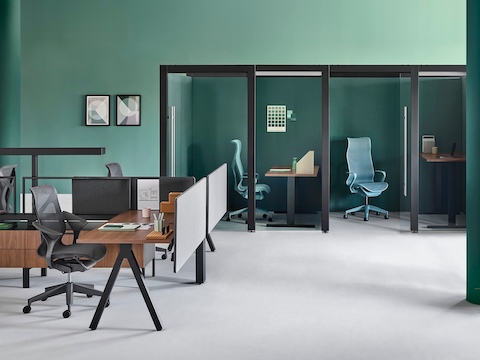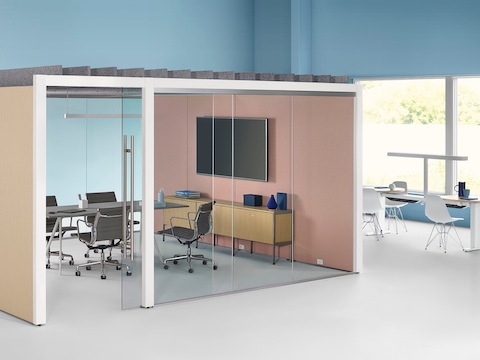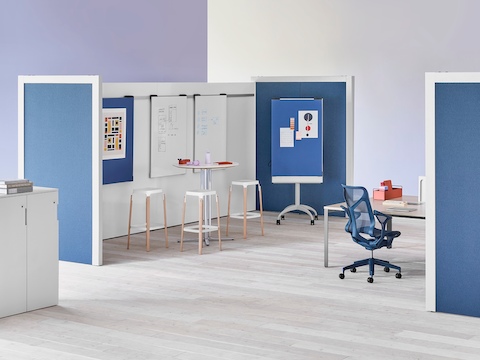Bringing Focus Back to the Open Office
Companies love the open office because it saves money, but people struggle to stay focused. Here's how to keep everyone happy.
Download PDF (522 KB)
Seventy percent of US office workers now work in open-plan offices. 1 While the press loves to disparage the open office, a massive global study shows that nine out of ten of the highest performing workplaces are either fully or extensively open plan. 2 That may be because a thoughtfully designed open plan can create conditions that encourage engagement. People are more likely to be engaged at work if they can move around, have privacy when they need it, and have access to spaces that let them connect with coworkers. 3
So why all the negative press? Because the exposed and chaotic nature of an open office can be awful. Lack of privacy and difficulty locating colleagues, meeting spaces, and resources can be distracting and lead to unhappiness at work. And excessive noise can impair a person's ability to remember information and do basic math. 4
Two Things to Get Right: Privacy and Spatial Legibility

Spatial Legibility
Organizations can improve spatial legibility by implying space, which means giving the illusion of space without physically demarcating it. Lighting, materiality, and easy-to-move objects and furnishings can help define a specific area or context—improving spatial legibility, privacy, or both. Solving those issues can be the difference between an open environment that people despise and one that works for the highest performing companies.

Privacy
Herman Miller has a variety of solutions that offer different levels of acoustic privacy and permanence (at the individual, group, and organizational level), as they imply space across the landscape. These solutions include movable desktop organizers, mobile carts, freestanding screens, and a freestanding, fully enclosed pod that's practically soundproof.
Another solution is Overlay, a new system of freestanding, sub-architectural, movable walls that create freestanding rooms, give shape to large open spaces, or simply divide one area from another.

First, it makes the landscape coherent by implying space to shape the environment. A sea of workspaces without clear divisions can look and feel chaotic. Overlay changes that, helping people intuitively navigate by creating a pattern of integrated but distinctive settings, some of which provide the visual privacy missing in the open plan. It makes spaces legible by defining areas, so people know which space will best support collaboration, catching up, or working alone.
Second, because it only has a select number of parts, Overlay simplifies space definition. A single boundary can function as a room divider. A three-sided workspace can become a designated area of impromptu meetings or collaborative work. Four Overlay walls can create an enclosed meeting space—complete with a door—that offers a higher level of visual and acoustical privacy.


Finally, Overlay is flexible and affordable, giving organizations the agility to evolve on the fly. With just two people and in about two hours, smaller applications of Overlay can be relocated with minimal disruption to the office and people working in it. It comes without the cost of prefabricated walls or the burden of traditional construction, minimizing downtime and cleanup.
Adaptability in workplace design has been important for quite some time, but the emergence of workplace data and analytics further underscores its value—both in improving the workplace experience for employees and in real estate asset allocation. For example, Herman Miller's Live OS provides real-time information about space utilization and employee well-being. With these insights, organizations know when to expand, consolidate, or reallocate space, as well as if people are getting the most from their ergonomic furniture.
The open plan first caught on because it can save organizations money. 5 But unless open plans are well designed, organizations are leaving money on the table in the form of reduced productivity 6 and lower employee satisfaction. 7
With Overlay, organizations have a new way to implement thoughtful designs that work for employees and the organization.
Notes
1. “IFMA’s New Space And Project Management Benchmarks.” Hok.Com. http://www.hok.com/ifmas-new-space-and-project-management benchmarks/. 2018.
2. Leesman, “The Next 250K.” June 2017.
3. Gallup. “State Of The American Workplace.” Washington D.C. 2017.
4. Perham, Nick. “Disliked Music Can Be Better for Performance Than Liked Music.” Applied Cognitive Psychology. Volume 26, Issue 4, July/August 2012. https://onlinelibrary.wiley.com/doi/pdf/10.1002/acp.2826
5. “Reconsidering Open-Plan—New Thinking On Productive Space | Regus”. Work New Zealand. https://www.regus.co.nz/work-newzealand/reconsidering-open-plannew-thinking-productive-space/. 2018.
6. “Reconsidering Open-Plan—New Thinking On Productive Space | Regus.” Work New Zealand. https://www.regus.co.nz/work-newzealand/reconsidering-open-plannew-thinking-productive-space/. 2018.
7. Neese, Brian. “The Open Office Layout Trend and Employee Productivity.” Rivier University | Online. https://online.rivier.edu/open-office-layout-and-employeeproductivity/. 2015.



